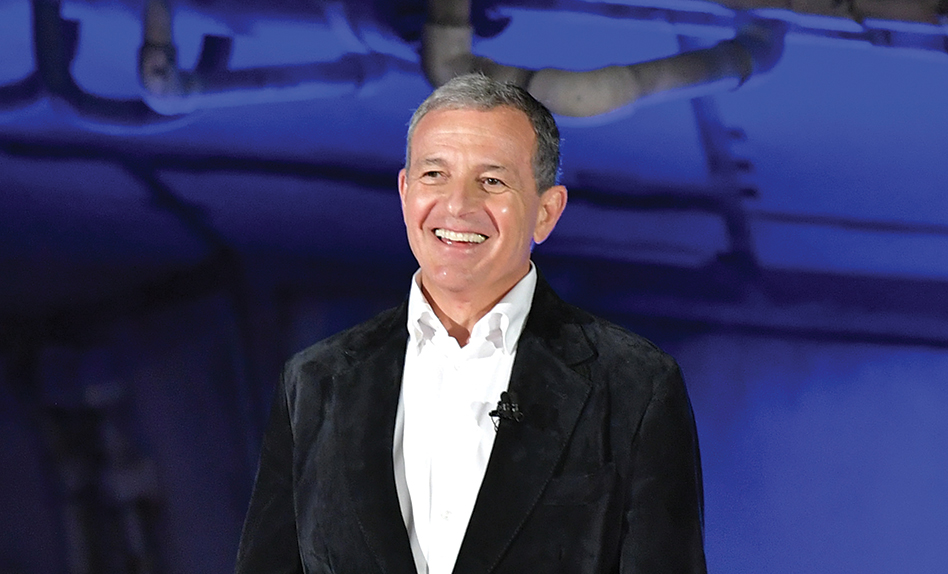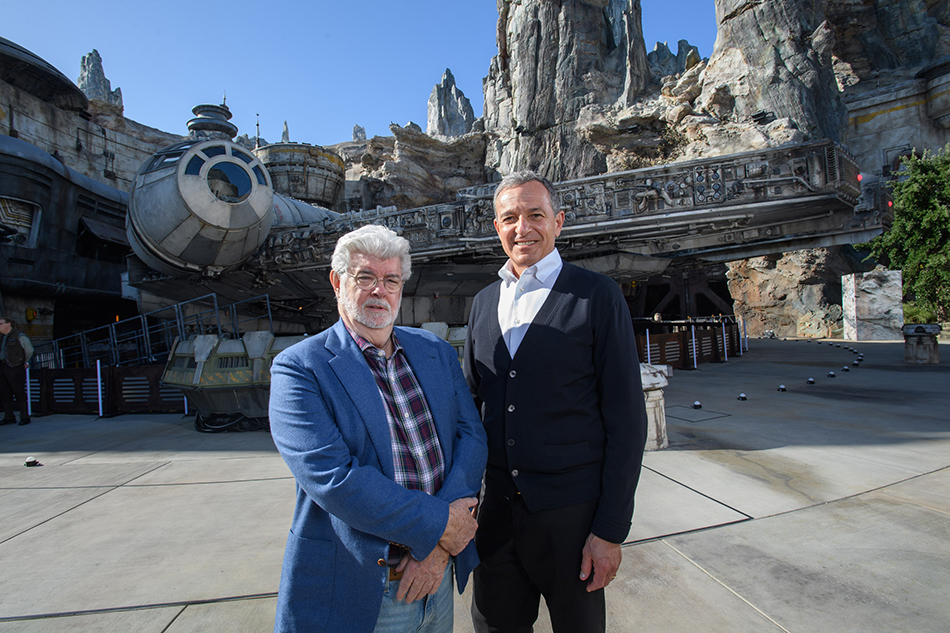Iger Scores Successful Shift To Streaming
There are more than 10 million reasons why The Walt Disney Co. chairman and CEO Bob Iger is Multichannel News’s executive of the year for 2019.
The first 10 million are the larger-than-expected number of people who signed up for the Disney+ streaming service on Nov. 12, the first day it was available.

Disney+ is the result of Iger, who started his career as a weatherman in Ithaca, New York, forecasting that technology was splintering the pay TV environment. The cord-cutting that resulted from viewers getting more choice about how they consume video was eating into Disney’s most profitable unit, ESPN.
“I think he’s done an incredible job of getting Disney+ off the ground,” said analyst Rich Greenfield of LightShed Partners, who is outspoken about the impending demise of the traditional TV business. “Technically, the quality of service is great and the breadth of content, especially old library content, is incredible.”
When Iger admitted on Disney’s fiscal third-quarter earnings call in 2015 that ESPN’s subscriber count was falling, the company’s stock dropped 7%. The same forces would impact the other TV businesses owned by Disney and those of its competitors.
After 13 years as CEO, Iger decided to be the disruptor instead of the disrupted. He bet the company on the idea that Disney could build a direct-to-consumer business on its trove of iconic content. His strategy was to turn Disney inside out. It stopped selling movies and shows to streaming competitors like Netflix, bought BAMTech to get a platform to launch ESPN+ and acquired 21st Century Fox to control even more content and streaming service Hulu.
Disrupting the Disruptors
Multichannel Newsletter
The smarter way to stay on top of the multichannel video marketplace. Sign up below.
With all those elements in place, Iger laid out the plans for Disney+ at an investor day held April 11 on the Burbank, California, movie lot where films like Mary Poppins were made.
“My grandparents took me to see Cinderella when I was a young boy, and just this last Christmas, I watched it with my grandchildren,” Iger told his audience. “That’s five generations of my family all entertained by the same film. And a perfect illustration of what evergreen means to us and just how much value it generates.”
While its films are timeless, Iger said it was time for Disney to find a new way to do business.
“A core tenet of ours since Walt founded the company is to create change and not just to sit back and watch it happen,” he said. “Now that’s not easy. It takes commitment, it takes perseverance, it takes patience and a lot of talent. And borrowing from one of Walt’s greatest strengths, it takes courage.”
Investors and analysts were shown the product, which would become the home for content from the company’s extraordinary brands: Disney, Pixar, Marvel, Star Wars, National Geographic, The Simpsons. It would have hit films like Avengers: Endgame, classics like Cinderella and original content like the Star Wars series The Mandalorian. They were told it would cost consumers just $6.99 a month and that the company expected it to have between 60 million and 90 million subs and turn profitable by 2024.
The next day, Disney stock jumped 12% to a then-record $130.06 per share.
By the time Disney reported its fiscal fourth-quarter earnings on Nov. 7, just days before the launch, Iger said that Disney+ was “the most important product that the company has launched” since he was in charge. Disney was “all in” and determined to “launch big and scale fast.”

Launch big and fast it did. Signing up 10 million subscribers in one day was “astounding,” said analyst Todd Juenger of Sanford C. Bernstein. “Before investor day, we were debating with investors whether Disney would get 10 million subs in the first year,” he said. “In recent months, the debate was whether Disney would be at 10 million subs when they reported fiscal first-quarter earnings in February. Nobody — not even the biggest bulls in their wildest dreams — expected 10 million signups in one day.”
According to Juenger, the launch added $18 billion to Disney’s market valuation in the four hours of trading after the company disclosed how many subscribers it had. (The company said it would not update the subscriber count until its next earnings report.)
Disney+ was not the first big bet Iger has made since becoming CEO in 2005. Iger was with ABC when it was acquired by Capital Cities and joined Disney when it purchased Capital Cities/ABC in 1995.
Picking a successor to then-Disney chairman and CEO Michael Eisner in 2005 was a difficult process, with the company going through a number of heirs apparent. Eventually Iger emerged as the only internal candidate for the top job. In a MasterClass presentation about business strategy released in November, Iger said a key part of convincing Disney’s board was outlining his priorities for the company, which he boiled down to three points: investing in creativity, using technology in ways to bring content to consumers in innovative ways and expanding internationally. “I got the job and the next step was to articulate them to the company and then ultimately to implement them,” Iger said.
A proponent of the value of brands, Iger convinced the board that Disney should buy Pixar for $7.4 billion in 2006, Marvel for $4 billion in 2009 and Lucasfilm, creator of Star Wars, for $4 billion in 2012. In 2019, those powerhouses would help Disney smash records by taking more than $10 billion at the box office, with Star Wars: The Rise of Skywalker set to open on Dec. 20.

Disney this year outbid Comcast for 21st Century Fox, paying $71 billion. After the acquisition, Iger continued to reorganize the company to emphasize streaming.
The new direction means big changes for many longtime Disney TV executives, some of whom had to leave the company following the Fox deal.
A former Disney executive who worked with Iger said that Iger is well-liked and good at getting the company to follow his lead.
“It’s one thing to go along with the company plan [and] another thing to believe it,” the executive said. “Bob’s good at that. They believe him. Everything he’s done, whether it’s Pixar, whether it’s Lucas, it’s worked out. He’s got more than the benefit of the doubt.”
That kind of communication is important to Iger. “Strategy is only as good as your ability to articulate it,” Iger said in his MasterClass presentation. “Clarity becomes incredibly important. Clarity actually is an essential ingredient to good leadership as well.
“When you lead people you need to be very, very clear about what you expect of them,” Iger added. “It’s very, very important that you communicate quite effectively with a set of people that ultimately are going to go out and implement your vision or your strategy across the company and I believe that that’s something that needs to happen. Not just once but on a constant basis.”
While Disney+ is off to a fast start, its future is not determined. IMA Research said that after five days Disney+ was up to 15 million subscribers. That compares favorably to 1.1 million subs for Apple TV+, which launched Nov. 1. On the other hand, a poll conducted by Express VPN found that 23% of Disney+ subscribers were likely to cancel within six months. If forced to choose, 35% said they’d pick Netflix over Disney+.
The streaming push also impacted Disney’s profits. Disney’s fiscal fourth-quarter earnings from continuing operations were down 72%.
“I think the unanswered question is: is Disney+ and Hulu just accelerating the collapse of the legacy ecosystem?” said analyst Greenfield. “Bob deserves credit for pivoting and finally realizing that the company had to make a meaningful shift and really lean in hard. But he still has a lot of assets tied to that legacy ecosystem. What happens to those? I don’t even know why he wants to own ESPN.”
Eyeing the End of the Ride
As for Iger’s future, the executive has already delayed his retirement to oversee the acquisition of 21st Century Fox and launch Disney+. He received $65.5 million in compensation for 2018. He was asked about how long he’d stay at the company during the Investor Day presentation in April.
“I have been CEO since October of 2005 and as I’ve said many times, there’s a time for everything and 2021 will be the time for me to finally step down,” said Iger, 68, who titled his recent memoir The Ride of a Lifetime. “I have been engaged with the board for quite some time in discussion about succession. And they’ve been engaged in a succession process, and we continue to feel that they will be able to identify my successor on a timely enough basis so that this company has a smooth transition.”
Jon has been business editor of Broadcasting+Cable since 2010. He focuses on revenue-generating activities, including advertising and distribution, as well as executive intrigue and merger and acquisition activity. Just about any story is fair game, if a dollar sign can make its way into the article. Before B+C, Jon covered the industry for TVWeek, Cable World, Electronic Media, Advertising Age and The New York Post. A native New Yorker, Jon is hiding in plain sight in the suburbs of Chicago.

